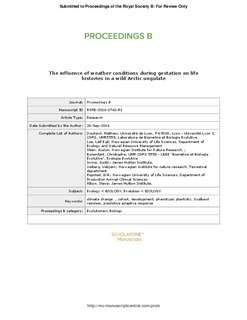| dc.contributor.author | Douhard, Mathieu | |
| dc.contributor.author | Loe, Leif Egil | |
| dc.contributor.author | Stien, Audun | |
| dc.contributor.author | Bonenfant, Christophe | |
| dc.contributor.author | Irvine, R. Justin | |
| dc.contributor.author | Veiberg, Vebjørn | |
| dc.contributor.author | Ropstad, Erik | |
| dc.contributor.author | Albon, Steve D. | |
| dc.coverage.spatial | Svalbard | nb_NO |
| dc.date.accessioned | 2016-11-07T10:49:26Z | |
| dc.date.accessioned | 2016-11-22T12:04:10Z | |
| dc.date.available | 2016-11-07T10:49:26Z | |
| dc.date.available | 2016-11-22T12:04:10Z | |
| dc.date.issued | 2016 | |
| dc.identifier.citation | Proceedings of the Royal Society of London. Biological Sciences 2016, 283 | nb_NO |
| dc.identifier.issn | 1471-2954 | |
| dc.identifier.uri | http://hdl.handle.net/11250/2422457 | |
| dc.description.abstract | The internal predictive adaptive response (internal PAR) hypothesis predicts
that individuals born in poor conditions should start to reproduce earlier if
they are likely to have reduced performance in later life. However, whether
this is the case remains unexplored in wild populations. Here,we use longitudinal
data from a long-term study of Svalbard reindeer to examine age-related
changes in adult female life-history responses to environmental conditions
experienced in utero as indexed by rain-on-snow (ROSutero). We show that
females experiencing high ROSutero had reduced reproductive success only
from 7 years of age, independent of early reproduction. These individuals
were able to maintain the same annual reproductive success between 2 and 6
years as phenotypically superior conspecifics that experienced low ROSutero.
Young females born after high ROSutero engage in reproductive events at
lower body mass (about 2.5 kg less) than those born after low ROSutero. The
mean fitness of females that experienced poor environmental conditions in
early lifewas comparable with that of females exposed to good environmental
conditions in early life. These results are consistent with the idea of internal
PAR and suggest that the life-history responses to early-life conditions can
buffer the delayed effects of weather on population dynamics.
climate change, cohort, development,
predictive adaptive response,
phenotypic plasticity, Svalbard reindeer | nb_NO |
| dc.language.iso | eng | nb_NO |
| dc.subject | climate change | nb_NO |
| dc.subject | cohort | nb_NO |
| dc.subject | development | nb_NO |
| dc.subject | predictive adaptive response | nb_NO |
| dc.subject | phenotypic plasticity | nb_NO |
| dc.subject | Svalbard reindeer | nb_NO |
| dc.title | The influence of weather conditions during gestation on life histories in a wild Arctic ungulate | nb_NO |
| dc.type | Journal article | nb_NO |
| dc.type | Peer reviewed | nb_NO |
| dc.date.updated | 2016-11-07T10:49:26Z | |
| dc.source.volume | 283 | nb_NO |
| dc.source.journal | Proceedings of the Royal Society of London. Biological Sciences | nb_NO |
| dc.identifier.doi | 10.1098/rspb.2016.1760 | |
| dc.identifier.cristin | 1396615 | |
